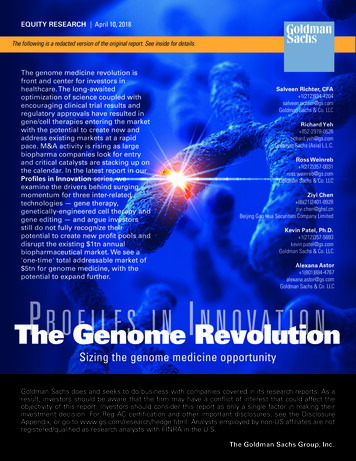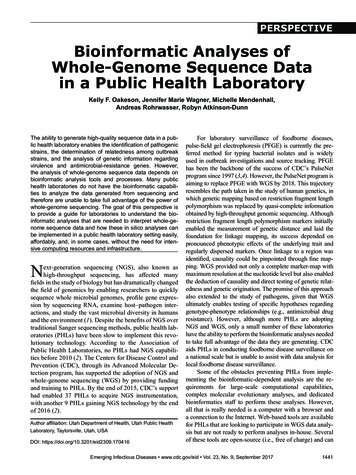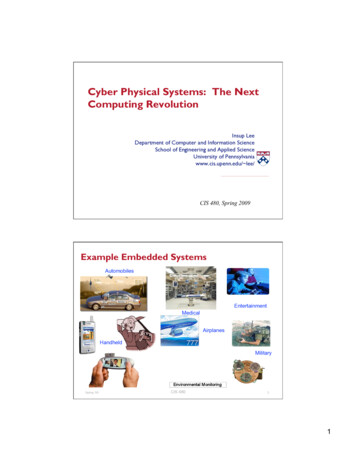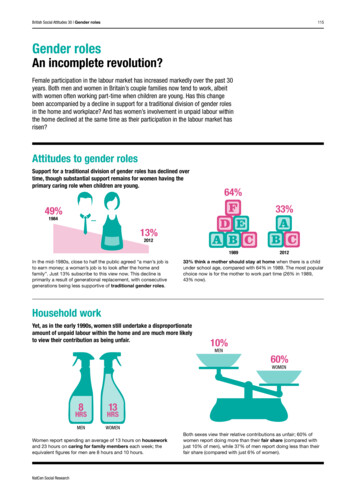
Transcription
EQUITY RESEARCH April 10, 2018The following is a redacted version of the original report. See inside for details.Salveen Richter, CFA 1(212)934-4204salveen.richter@gs.comGoldman Sachs & Co. LLCRichard Yeh 852-2978-0526richard.yeh@gs.comGoldman Sachs (Asia) L.L.C.Ross Weinreb 1(212)357-0031ross.weinreb@gs.comGoldman Sachs & Co. LLCZiyi Chen 86(21)2401-8928ziyi.chen@ghsl.cnBeijing Gao Hua Securities Company LimitedKevin Patel, Ph.D. 1(212)357-5693kevin.patel@gs.comGoldman Sachs & Co. LLCAlexana Astor 1(801)884-4767alexana.astor@gs.comGoldman Sachs & Co. LLCPROFILESININNOVATIONThe Genome RevolutionSizing the genome medicine opportunityGoldman Sachs does and seeks to do business with companies covered in its research reports. As aresult, investors should be aware that the firm may have a conflict of interest that could affect theobjectivity of this report. Investors should consider this report as only a single factor in making theirinvestment decision. For Reg AC certification and other important disclosures, see the DisclosureAppendix, or go to www.gs.com/research/hedge.html. Analysts employed by non-US affiliates are notregistered/qualified as research analysts with FINRA in the U.S.The Goldman Sachs Group, Inc.ada35f44e8874374a481b2cafd55b359The genome medicine revolution isfront and center for investors inhealthcare. The long-awaitedoptimization of science coupled withencouraging clinical trial results andregulatory approvals have resulted ingene/cell therapies entering the marketwith the potential to create new andaddress existing markets at a rapidpace. M&A activity is rising as largebiopharma companies look for entryand critical catalysts are stacking up onthe calendar. In the latest report in ourProfiles in Innovation series, weexamine the drivers behind surgingmomentum for three inter-relatedtechnologies — gene therapy,genetically-engineered cell therapy andgene editing — and argue investorsstill do not fully recognize theirpotential to create new profit pools anddisrupt the existing 1tn annualbiopharmaceutical market. We see a'one-time' total addressable market of 5tn for genome medicine, with thepotential to expand further.
Goldman SachsProfiles in InnovationTable of ContentsPM Summary3The age of genome medicine4Sizing the genome medicine opportunity16Sustainability and pricing.20The venture landscape23The outlook for IPOs and M&A24Genome medicine: the next wave26Gene Therapy in China35Manufacturing genome medicines36Appendix: DNA - Life’s blueprint39Disclosure Appendix43Note: The following is a redacted version of “Profiles in Innovation: The Genome Revolution” originallypublished April 10, 2018 [71pgs]. All company references in this note are for illustrative purposes only andshould not be interpreted as investment recommendations.2
Goldman SachsProfiles in InnovationPM SummaryGenome medicine represents a new era. The manipulation of genes, the ‘blueprint’ oflife that determines human attributes from our eye color to the risk of developing heartdisease, has become a reality. Driven by advances in scientific knowledge (such as thediscovery of the CRISPR/Cas9 gene editing system) and exponential declines in genomesequencing costs, scientists are increasingly able to target the genetic cause of adisease and repair it at the source by replacing or editing genes or introducinggenetically-engineered cells. Given genes are the foundation of all biological activity, webelieve genome medicine has transformative potential across the entire spectrum ofdisease categories (cancer, neurology, ophthalmology, liver, etc) and represents a 4.8tntotal addressable market (TAM), derived from the creation of new profit pools as well asdisruption of the 1tn (annual sales) biopharmaceutical industry. Its emergence may alsohave profound implications for the current healthcare and payor system, which is notdesigned to accommodate high costs for therapies that may prove to be potentially‘one-time curative’ treatments ( 1mn for the first EU-approved gene therapy drugGlybera). However, the nature of genome medicines also introduces a new dynamicwhere the prevalent patient population gradually becomes smaller. Further, this couldresult in an increase in “diseases of aging.”We believe investors underappreciate the potential for genome medicine to not onlyaddress rare diseases with no existing or limited treatments but also the much largermarkets for common diseases. For example, success in CAR T cell therapy is raising thepossibility that gene therapies could initially serve as last-line treatments in cancer,opening new markets, but then progress to front-line settings with potentialrepercussions for incumbents.We interview leading scientists in the field and discuss how gene editing offers thepotential to further the progress of genome medicine. As the pace of discovery anddevelopment in genome medicine accelerates, we expect companies that innovate toadvance next-generation technologies will gain a competitive advantage.3
Goldman SachsProfiles in InnovationThe age of genome medicineGene therapy: 2.0 (vs. 1.0 - a false start)Gene therapy emerged as a concept in the 1970s following the publication of a paper inScience titled “Gene therapy for human genetic disease,” which proposed the use ofhealthy DNA to replace defective DNA (typically inherited from parents or developed inutero due to outside factors such as stress, physical or chemical injury) in patients withgenetic disorders. The severity of a genetic disease is correlated with the number androle of the genes encompassed in the defective DNA portion. For example, defects in agene involved in key cellular mechanisms of growth and development may havewidespread effect, often impacting multiple organs. While genetic disorders tend toimpact small patient populations (rare diseases are defined as fewer than 200k patientsin the U.S. or 1 in 2k in the E.U.), only a minority of these diseases have approvedtherapies. Of these drugs, most do not address the underlying disease cause andinstead serve to manage symptoms. Thus, the prospect of addressing the underlyingcause of disease with a potential “one-time cure” has always been appealing. Earlyclinical studies at the National Institute of Health (NIH) Clinical Center revolved arounddeveloping a gene therapy in enzyme (ADA)-deficient patients with severe combinedimmunodeficiency (SCID), which delivered a functional copy of the gene into cells exvivo (outside the body) using a lentiviral approach and then transferred the cells backinto the body. However, an experimental gene therapy developed at the University ofPennsylvania to treat ornithine transcarbamylase (OTC) deficiency resulted in the deathof an 18-year old in 1999 and led to a significant setback to clinical research in genetherapy.The birth of the genome revolutionDrug development in biotechnology has greatly accelerated due to the Human GenomeProject, which resulted in sequencing of the human genome in 2003 enabling scientiststo identify novel genetic targets that cause disease. In addition, since 2001, the cost ofsequencing the human genome has declined faster than Moore’s law would predict, to 1k from 100mn. As the cost of sequencing a single genome improves, so does thedrug developer’s ability to 1) identify key biological genetic targets to address underlyingdisease, 2) generate animal models with predictive potential to ascertain clinical benefitin humans, and 3) identify biomarkers that are early indicators of drug activity and safety.These, combined with advances in the understanding and development of deliveryplatforms (such as lipid nanoparticles and viral vectors), more rigorous regulatoryoversight, higher clinical safety standards, and ethical questions, have spurred are-emergence of interest and efforts to develop safer and more efficacious genometherapies.4
Goldman SachsProfiles in InnovationExhibit 1: The decline in cost of human genome sequencing has outpaced Moore’s law and boosted R&DSource: National Human Genome Institute, Goldman Sachs Global Investment ResearchExhibit 2: Key events in the evolution of genome medicineSource: Goldman Sachs Global Investment ResearchThe promise of genome medicineIt is difficult to overstate the promise of genome medicine, which includes three distinctbut inter-related technologies: gene therapy, genetically-engineered cell therapy, andgene editing—they hold the potential to be life-changers for patients, game-changers forhealthcare investors, and game-enders for incumbents who fail to respond to thepressure to innovate. Understanding the science behind these technologies puts this5
Goldman SachsProfiles in Innovationinto perspective. That said, while genome medicines are emerging with compellingefficacy and safety profiles, we are still in early stages and optimization is occurring onmultiple fronts.Today, most chronic disorders require lifelong treatment. For example, severehemophiliacs require 50 infusions a year, while patients administeredimmuno-oncology drug Keytruda typically visit their physician every three weeks. Incontrast, gene and cell therapies have the potential to be “one shot cures” or at the veryleast less-frequent treatments, targeting diseases at the genetic level. While they arebeing tested (and proven effective) as treatments of “last resort,” these therapies couldnext move into earlier stages of disease progression, which would disrupt existingtherapeutic markets. In diseases where there are no current treatment options (manyrare diseases), new profit pools are formed.Exhibit 3: Genome medicine: Three inter-related nt UsesFutureEnhancementsGeneTherapyinjectcorrected geneviral vectorAAV( ): produces missingor fixed protein(-): virus supplysevere diseasesrepeat dosingCellTherapyreinfuseenhanced cellsviral vector cell infusionCAR TTCR( ): efficacy in last linecancer setting(-): virus supply;manufacturing timecancerallogeneic(off the shelf)"molecular scissors"viral vector orfat-lined capsuleZFNTALENCRISPRmeganucleases( ): permanent changein genome(-): virus supply; noclinical datasevere diseasesagriculturemultiple genetargetingGeneEditingSource: Goldman Sachs Global Investment ResearchHow does gene therapy work?Many diseases — from heart disease to Parkinson’s disease — can be traced back todifferences in the body’s genetic code. Gene therapy is designed to fix these problemsat the source by inserting or editing a corrected DNA sequence that can override theexisting error.While it may seem counterintuitive, viruses are uniquely suited to deliver the correctedgene into the body. A disease-causing virus, e.g. influenza virus, consists of a proteinshell (capsid) that hones in on a specific cell type, e.g. respiratory tract mucosa, andinjects its genetic payload into the host cell which then replicates and releases morevirus particles to infect other cells in the body. Gene therapy co-opts this ability, strippingthe virus of its pathogenic properties (at which point it is defined as a vector) andleveraging its ability to inject (in this case corrected) genetic material into target tissuesand cells. Gene therapy can be used to deliver genetic material to both replacedefective/deficient genes, e.g. replace SMN1 protein in spinal muscular atrophy, or to‘silence’ defective disease-causing genes, e.g. tau protein knockdown in Alzheimer’sdisease.The type of virus and how it is engineered depends on the target condition:6
Goldman SachsProfiles in Innovation1. Lentiviral vectors: Derived from the HIV-1 virus, these vectors inject the correctedgene which is then incorporated into the target cell’s DNA, ensuring the fix will bepassed on to all future daughter cells when the host cell divides. This makeslentiviral vectors ideal for treating diseases involving frequently dividing cells, suchas blood cancers.2. Adeno-associated virus vectors: Unlike lentiviral vectors, adeno-associated or“AAV” vectors do not insert their DNA cargo into the host DNA; instead, thesevectors deposit the corrected gene just outside the genome in the host cell’snucleus. When the host cell divides, only one of the daughter cells will inherit the“fix”—thus AAV is best suited for tissues that do not divide rapidly, such as the liver,eye, muscle, or nerve cells.The resurgence of interest in developing genome medicines (gene and CAR Ttherapies), by commercial biotechnology companies as well as academic centers, hasresulted in significant demand for viral vectors. Given just five years ago, virusengineering was confined to a handful of labs, current commercial scale needs haveoutpaced supply due to the complexity and rigorous specifications of manufacturing.Some companies are also targeting gene therapy platform construction more broadly,equipping themselves with not only the required virus supply but also the tools to buildvectors capable of venturing into new tissues and thus new disease areas.Exhibit 4: Vector selection is key for target tissue/organ specificitySource: Goldman Sachs Global Investment ResearchCell therapy: Cells engineered to fight cancer (CAR T and TCR)Cell therapy is a technology that leverages the ability of gene therapy to insert a desiredgene into a cell (which is then translated into a protein to serve a specific function) andworks at a cellular level to infuse enhanced cells into the body to fight disease. In cancerspecifically, engineered immune cells (T cells) have made notable advances, with CAR Tand TCR as two of the most advanced cell therapies. In the case of chimeric antigenreceptor (CAR) T or T-cell receptor (TCR) therapies, T cells from patients are harvestedand a lentiviral gene therapy is used to insert a CAR directed to a specific antigenprotein on cancer cells. These T cells are then grown and re-infused into patients so thatthese ‘enhanced’ T cells have a new ability to recognize and clear specific cancer cells inthe body. Although multiple CAR T candidates are being developed for bl
04.09.2019 · Goldman Sachs does and seeks to do business with companies covered in its research reports. As a result, investors should be aware that the firm may have a conflict of interest that could affect the objectivity of this report. Investors should consider this report as only a single factor in making their investment decision. For Reg AC certification and other important disclosures, see the .











